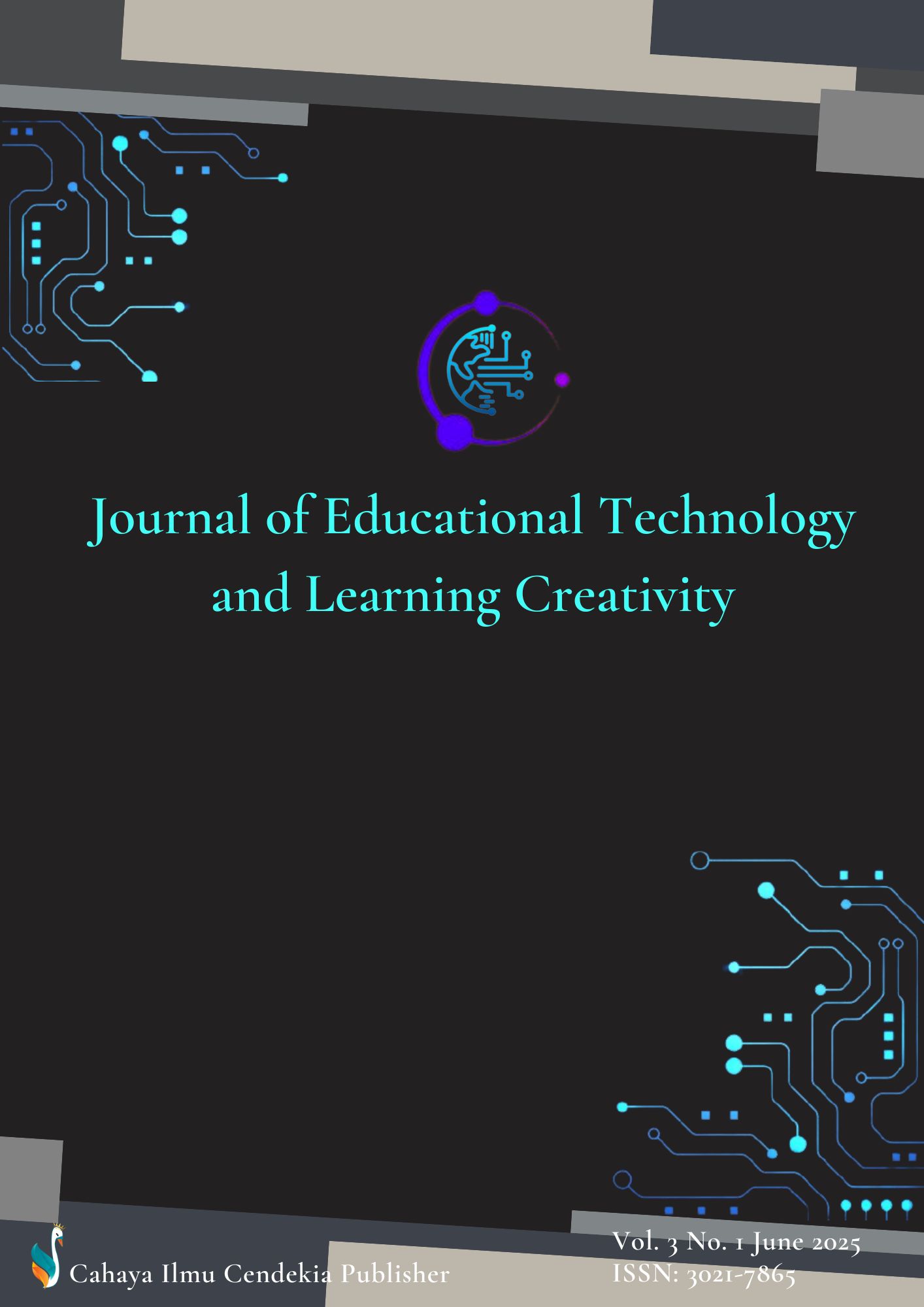The Influence of Android-Based Augmented Reality Learning Media on Student Learning Outcomes in Atomic Model Material
Abstract
Purpose of the study: This study aims to determine the effect of Android-based augmented reality (AR) learning media on student learning outcomes in atomic model material.
Methodology: This study is a quantitative study with a quasi-experimental design using a one-shot case study approach. The research sample consisted of 70 grade X students at State Senior High School 29 Jakarta who were given treatment in the form of learning using Android-based augmented reality media. The research instrument was in the form of multiple-choice objective posttest questions that had been validated and equipped with grids. Data analysis was carried out using a simple linear regression test to determine the effect of the use of augmented reality media on student learning outcomes.
Main Findings: The results of the analysis show that Android-based augmented reality media has a significant influence on student learning outcomes with a significance value of 0.000 (<0.05) and a coefficient of determination (R²) of 0.453. This shows that 45.3% of the variation in student learning outcomes can be explained by the use of augmented reality media. This media helps students understand the abstract concept of the atomic model more visually and interactively.
Novelty/Originality of this study: This research is part of a further research (dissemination) that tests the effectiveness of previously developed Android-based augmented reality media. The uniqueness of this research lies in the focus of its implementation on abstract chemical material and the use of experimental design in a real learning environment.
References
L. T. Hang and V. H. Van, “Building strong teaching and learning strategies through teaching innovations and learners' creativity: A study of Vietnam universities,” Int. J. Educ. Pract., vol. 8, no. 3, pp. 498–510, 2020, doi: 10.18488/journal.61.2020.83.498.510.
D. Davies, D. Jindal-Snape, C. Collier, R. Digby, P. Hay, and A. Howe, “Creative learning environments in education—A systematic literature review,” Think. Skills Creat., vol. 8, pp. 80–91, 2013, doi: 10.1016/j.tsc.2012.07.004.
M. S. Sumbawati, I. Basuki, E. Ismayati, and T. Rijanto, “Student learning independence in online learning depends on motivation,” in Proc. Int. Joint Conf. Sci. Eng. (IJCSE 2020), pp. 342–347, Nov. 2020, doi: 10.2991/aer.k.201124.062.
U. B. A. Ordu, “The role of teaching and learning aids/methods in a changing world,” Bulgarian Comparative Education Society, pp. 210–216, 2021. https://eric.ed.gov/?id=ED613989
M. M. Asad, N. Hussain, M. Wadho, Z. H. Khand, and P. P. Churi, “Integration of e-learning technologies for interactive teaching and learning process: An empirical study on higher education institutes of Pakistan,” J. Appl. Res. High. Educ., vol. 13, no. 3, pp. 649–663, 2021, doi: 10.1108/JARHE-04-2020-0103.
Ü. Alan, “Distance education during the COVID-19 pandemic in Turkey: Identifying the needs of early childhood educators,” Early Child. Educ. J., vol. 49, no. 5, pp. 987–994, 2021, doi: 10.1007/s10643-021-01197-y.
C. Novella-García and A. Cloquell-Lozano, “The ethical dimension of digital competence in teacher training,” Educ. Inf. Technol., vol. 26, no. 3, pp. 3529–3541, 2021, doi: 10.1007/s10639-021-10436-z.
E. Luria, Z. Gross, and M. Rothgangel, “Unveiling the power of educational media: Enhancing immersion and affective engagement in Holocaust education through virtual reality,” Educ. Media Int., pp. 1–25, 2025, doi: 10.1080/09523987.2025.2490914.
M. Y. P. Peng, Y. Xu, and C. Xu, “Enhancing students’ English language learning via M-learning: Integrating technology acceptance model and SOR model,” Heliyon, vol. 9, no. 2, 2023, doi: 10.1016/j.heliyon.2023.e13302.
H. Hong and Y. Kim, “Applying artificial intelligence in career education for students with intellectual disabilities: The effects on career self-efficacy and learning flow,” Educ. Inf. Technol., pp. 1–20, 2024, doi: 10.1007/s10639-024-12809-6.
A. O. Adu-Marfo, O. A. T. F. Kwapong, Y. Oheneba-Sakyi, and J. Miller-Young, “Understanding teachers’ usage of YouTube as a pedagogical tool: A qualitative case study of basic school teachers in Ghana,” E-Learning Digit. Media, 2024, doi: 10.1177/20427530241239393.
S. Mukhamadiyeva and D. Hernández-Torrano, “Adaptive learning to maximize gifted education: Teacher perceptions, practices, and experiences,” J. Adv. Acad., vol. 35, no. 4, pp. 652–670, 2024, doi: 10.1177/1932202X241253166.
J. Cai and Y. Li, “Fuzzy association rule mining for personalized English language teaching from higher education,” J. Comput. Methods Sci. Eng., vol. 24, no. 6, pp. 3617–3631, 2024, doi: 10.1177/14727978241296748.
A. B. Semma, M. Ali, and M. I. Helmy, “Multi-dimensional challenges in the Indonesian social science information technology-based learning: A systematic literature review,” Heliyon, 2024, doi: 10.1016/j.heliyon.2024.e28706.
A. Ioannou and S. Retalis, “Building entrepreneurial self-efficacy in the EdTech sector: The impact of an entrepreneurship education program,” Int. J. Inf. Learn. Technol., 2025, doi: 10.1108/IJILT-12-2023-0234.
K. S. Kaswan, J. S. Dhatterwal, and A. Pandey, “Evolution of educational technology,” in Adv. Learn. Teach. High. Educ. India: Policy-Technol.-Capacity Enabled Approach, River Publishers, 2024, pp. 307–321, doi: 10.1201/9781032631226-21.
R. da Silva Tiago and A. Mitchell, “Integrating digital transformation in nursing education: Best practices and challenges in curriculum development,” in Digit. Transform. High. Educ., Part B, Emerald Publishing Limited, 2024, pp. 57–101, doi: 10.1108/978-1-83608-424-220241004.
A. Nursalim and A. Suryadi, “La teak: Painted animation as an educational media maintaining tree sustainability AR 3D filter-based,” Digit. Appl. Archaeol. Cult. Herit., vol. 34, p. e00339, 2024, doi: 10.1016/j.daach.2024.e00339.
A. Hamdan, A. K. Putra, I. Tan, and S. N. Farihah, “Geo-Virtual Reality (GVR): The creative materials to construct spatial thinking skills using virtual learning based metaverse technology,” Think. Skills Creat., vol. 54, p. 101664, 2024, doi: 10.1016/j.tsc.2024.101664.
Y. Zhao and Q. Wang, “Applying augmented reality multimedia technology to construct a platform for translation and teaching system,” Heliyon, vol. 10, no. 7, 2024, doi: 10.1016/j.heliyon.2024.e28700.
K. Broman, S. Bernholt, and C. Christensson, "Relevant or interesting according to upper secondary students? Affective aspects of context-based chemistry problems," Research in Science & Technological Education, vol. 40, no. 4, pp. 478–498, 2022, doi: 10.1080/02635143.2020.1824177.
L. Y. Midak, I. V. Kravets, O. V. Kuzyshyn, L. V. Baziuk, and K. V. Buzhdyhan, "Specifics of using image visualization within education of the upcoming chemistry teachers with augmented reality technology," in Journal of Physics: Conference Series, vol. 1840, no. 1, p. 012013, Mar. 2021, doi: 10.1088/1742-6596/1840/1/012013.
M. Abdinejad, B. Talaie, H. S. Qorbani, and S. Dalili, "Student perceptions using augmented reality and 3D visualization technologies in chemistry education," Journal of Science Education and Technology, vol. 30, pp. 87–96, 2021, doi: 10.1007/s10956-020-09880-2.
M. Alrige, H. Bitar, W. Al-Suraihi, K. Bawazeer, and E. Al-Hazmi, "MicroWorld: An augmented-reality Arabian app to learn atomic space," Technologies, vol. 9, no. 3, p. 53, 2021, doi: 10.3390/technologies9030053.
G. Lampropoulos, E. Keramopoulos, K. Diamantaras, and G. Evangelidis, "Augmented reality and gamification in education: A systematic literature review of research, applications, and empirical studies," Applied Sciences, vol. 12, no. 13, p. 6809, 2022, doi: 10.3390/app12136809.
Y. J. Lin and H. C. Wang, "Applying augmented reality in a university English class: Learners’ perceptions of creativity and learning motivation," Innovation in Language Learning and Teaching, vol. 17, no. 2, pp. 291–305, 2023, doi: 10.1080/17501229.2022.2040513.
Y. J. Liao, W. Tarng, and T. L. Wang, "The effects of an augmented reality lens imaging learning system on students’ science achievement, learning motivation, and inquiry skills in physics inquiry activities," Education and Information Technologies, vol. 30, no. 4, pp. 5059–5104, 2025, doi: 10.1007/s10639-024-12973-9.
H. Romadiah, P. Dayurni, and L. E. W. Fajari, "Meta-analysis study: The effect of android-based learning media on student learning outcomes," International Journal of Asian Education, vol. 3, no. 4, pp. 253–263, 2022, doi: 10.46966/ijae.v3i4.300.
Y. R. R. Rosyid and N. Setyasto, "Development of Android-based augmented reality learning media on the human respiratory system to improve student learning outcomes," Jurnal Penelitian Pendidikan IPA, vol. 10, no. 5, pp. 2503–2510, 2024, doi: 10.29303/jppipa.v10i5.7024.
V. K. Kuit and K. Osman, "CHEMBOND3D e-module effectiveness in enhancing students’ knowledge of chemical bonding concept and visual-spatial skills," European Journal of Science and Mathematics Education, vol. 9, no. 4, pp. 252–264, 2021, doi: 10.30935/scimath/11263.
M. Pikoli and A. Lukum, "Development of audio-visual learning media integrating character education in chemistry learning to facilitate conceptual change and character strengthening of high school students," in Journal of Physics: Conference Series, vol. 1968, no. 1, p. 012007, Jul. 2021, doi: 10.1088/1742-6596/1968/1/012007.
C. Nakiboğlu and N. Nakiboğlu, "Views of prospective chemistry teachers on the use of graphic organizers supported with interactive PowerPoint presentation technology in teaching electrochemistry concepts," International Journal of Physics and Chemistry Education, vol. 13, no. 3, pp. 47–63, 2021, doi: 10.51724/ijpce.v13i3.216.
S. Özeren and E. Top, "The effects of augmented reality applications on the academic achievement and motivation of secondary school students," Malaysian Online Journal of Educational Technology, vol. 11, no. 1, pp. 25–40, 2023, doi: 10.52380/mojet.2023.11.1.425.
A. M. F. Yousef, "Augmented reality assisted learning achievement, motivation, and creativity for children of low‐grade in primary school," Journal of Computer Assisted Learning, vol. 37, no. 4, pp. 966–977, 2021, doi: 10.1111/jcal.12536.
S. A. Elsayed and H. I. Al-Najrani, "Effectiveness of the augmented reality on improving the visual thinking in mathematics and academic motivation for middle school students," Eurasia Journal of Mathematics, Science and Technology Education, vol. 17, no. 8, p. em1991, 2021, doi: 10.29333/ejmste/11069.
R. Rosmiati, I. Isrokatun, N. Hanifah, Y. A. Rohman, and R. Khoerunnisah, "The development of android-based learning mobile app to practice critical thinking skills for elementary school students," Pegem Journal of Education and Instruction, vol. 13, no. 2, pp. 161–172, 2023, doi: 10.47750/pegegog.13.02.20.
M. D. Dasopang, "Effectivity of interactive multimedia with theocentric approach to the analytical thinking skills of elementary school students in science learning," Premiere Educandum: Jurnal Pendidikan Dasar Dan Pembelajaran, vol. 11, no. 2, pp. 215–226, 2021, doi: 10.25273/pe.v11i2.9658.
S. Nahar, "Improving students' collaboration thinking skill under the implementation of the quantum teaching model," International Journal of Instruction, vol. 15, no. 3, pp. 451–464, 2022, doi: 10.29333/iji.2022.15325a.
F. Nyimbili and L. Nyimbili, "Types of purposive sampling techniques with their examples and application in qualitative research studies," British Journal of Multidisciplinary and Advanced Studies, vol. 5, no. 1, pp. 90–99, 2024, doi: 10.37745/bjmas.2022.0419.
F. B. Thomas, "The role of purposive sampling technique as a tool for informal choices in a social sciences in research methods," Just Agriculture, vol. 2, no. 5, pp. 1–8, 2022.
D. Hossan, Z. Dato’Mansor, and N. S. Jaharuddin, "Research population and sampling in quantitative study," International Journal of Business and Technopreneurship (IJBT), vol. 13, no. 3, pp. 209–222, 2023, doi: 10.58915/ijbt.v13i3.263.
S. Hassan, S. P. Venkateswaran, and V. D. Nadarajah, "Evaluation of immediate impact of Faculty Development Programme using a pretest–post-test study design format," Innovation and Education, vol. 3, no. 1, p. 1, 2021, doi: 10.1186/s42862-021-00009-9.
U. A. Purba and Z. Azis, "The effectiveness of problem based learning model on the ability to solve mathematical problems in terms of students' analytical thinking ability," JMEA: Journal of Mathematics Education and Application, vol. 1, no. 2, pp. 73–80, 2022, doi: 10.30596/jmea.v1i2.10553.
R. Handayani, G. Sakkir, and R. Kasman, "The influence of verbal-linguistic intelligence on students' learning outcomes in English at SMA Negeri 1 Sidrap," EduLine: Journal of Education and Learning Innovation, vol. 1, no. 2, pp. 141–148, 2021, doi: 10.35877/454RI.eduline606.
D. Alita, A. D. Putra, and D. Darwis, "Analysis of classic assumption test and multiple linear regression coefficient test for employee structural office recommendation," IJCCS (Indonesian Journal of Computing and Cybernetics Systems), vol. 15, no. 3, pp. 295–306, 2021, doi: 10.22146/ijccs.65586.
M. Mohzana, M. Fahrurrozi, and H. Murcahyanto, "The effect of leadership and work motivation on operator performance," AL-ISHLAH: Jurnal Pendidikan, vol. 14, no. 2, pp. 1207–1218, 2022, doi: 10.35445/alishlah.v14i2.2023.
R. R. Alhempi and B. Supeno, "Effect of training and motivation on employees performance of the environment and forestry department of Riau province," Husnayain Business Review, vol. 1, no. 1, pp. 60–68, 2021, doi: 10.54099/hbr.v1i1.8.
A. Amores-Valencia, D. Burgos, and J. W. Branch-Bedoya, "The impact of augmented reality (AR) on the academic performance of high school students," Electronics, vol. 12, no. 10, p. 2173, 2023, doi: 10.3390/electronics12102173.
K. A. Bölek, G. De Jong, and D. Henssen, "The effectiveness of the use of augmented reality in anatomy education: a systematic review and meta-analysis," Scientific Reports, vol. 11, no. 1, p. 15292, 2021, doi: 10.1038/s41598-021-94721-4.
E. Çetinkaya Özdemir and H. Akyol, "Effect of augmented reality-based reading activities on some reading variables and participation in class," International Journal of Progressive Education, vol. 17, no. 4, pp. 135–154, 2021, doi: 10.29329/ijpe.2021.366.9.
I. Shatz, "Assumption-checking rather than (just) testing: The importance of visualization and effect size in statistical diagnostics," Behavior Research Methods, vol. 56, no. 2, pp. 826–845, 2024, doi: 10.3758/s13428-023-02072-x.
E. M. Sinaga, "The influence of price on purchase decision with quality of service as intervening variable," JPPI (Jurnal Penelitian Pendidikan Indonesia), vol. 9, no. 1, pp. 125–133, 2023, doi: 10.29210/020221734.
S. W. Kesumo, D. Suprayitno, and W. Latunreng, "The effect of inventory control on the work productivity of inventory division employees at PT Duta Sentosa Yasa (MR DIY) KBN Marunda," Sinergi International Journal of Logistics, vol. 2, no. 1, pp. 1–16, 2024, doi: 10.61194/sijl.v2i1.120.
M. Fakih, "Step into a new dimension with augmented reality. Can Augmented Reality (AR) replicate the tactile experience in a virtual mathematics classroom and what is the impact on engagement and deeper understanding?," Research in Post-Compulsory Education, vol. 28, no. 2, pp. 226–240, 2023, doi: 10.1080/13596748.2023.2206707.
F. del Cerro Velázquez and G. Morales Méndez, "Application in augmented reality for learning mathematical functions: A study for the development of spatial intelligence in secondary education students," Mathematics, vol. 9, no. 4, p. 369, 2021, doi: 10.3390/math9040369.
D. Rohendi, M. O. Ramadhan, S. S. A. Rahim, and H. Zulnaidi, "Enhancing student’s interactivity and responses in learning geometry by using augmented reality," Eurasia Journal of Mathematics, Science and Technology Education, vol. 21, no. 1, p. em2559, 2025, doi: 10.29333/ejmste/15796.
B. J. Siregar, L. Ndruru, and S. P. Tamba, "Android-based learning media for vocational high school students," International Journal of Natural Science and Engineering, vol. 5, no. 2, pp. 39–48, 2021, doi: 10.23887/ijnse.v5i2.37080.
J. N. Nabayra, "On-the-go android-based learning tool for mathematics in geographically challenged areas," International Journal of Learning, Teaching and Educational Research, vol. 23, no. 8, pp. 643–667, 2024.
A. Abdullah, W. Nugraha, S. Sutiyo, R. F. Setiawan, M. I. D. Saputra, and R. P. Putra, "Learning media development: FireDroid application base on the Android system and distance learning," Journal of Airport Engineering Technology (JAET), vol. 2, no. 01, pp. 33–39, 2021, doi: 10.52989/jaet.v2i01.47.
M. Lubis and F. Ariansyah, "The use of deep learning to improve teaching and learning in Islamic schools," JPCIS: Journal of Pergunu and Contemporary Islamic Studies, vol. 1, no. 1, pp. 170–193, 2024. [Online]. Available: https://jurnal.pcpergunukotapasuruan.org/index.php/jpcis/article/view/22.
D. Mdhlalose, "Integration of technology in education and its impact on learning and teaching," Asian Journal of Education and Social Studies, vol. 47, no. 2, pp. 10–9734, 2023, doi: 10.9734/AJESS/2023/v47i21021.
M. A. AlGerafi, Y. Zhou, M. Oubibi, and T. T. Wijaya, "Unlocking the potential: A comprehensive evaluation of augmented reality and virtual reality in education," Electronics, vol. 12, no. 18, p. 3953, 2023, doi: 10.3390/electronics12183953.
E. Murniarti, H. Prayitno, G. A. Wibowo, S. Suparmi, E. Yuliani, and R. Rochmah, "Implementing augmented reality in inclusive education: Experiments and potential," International Journal of Science and Society, vol. 5, no. 4, pp. 60–72, 2023.
Copyright (c) 2025 Syamiluddin Syamiluddin, Roel Ang, Alvic Torres, Edwin Auditor

This work is licensed under a Creative Commons Attribution 4.0 International License.
Authors who publish with this journal agree to the following terms:
- Authors retain copyright and acknowledge that the Journal of Educational Technology and Learning Creativity is the first publisher licensed under a Creative Commons Attribution 4.0 International License.
- Authors are able to enter into separate, additional contractual arrangements for the non-exclusive distribution of the journal's published version of the work (e.g., post it to an institutional repository or publish it in a book), with an acknowledgment of its initial publication in this journal.
- Authors are permitted and encouraged to post their work online (e.g., in institutional repositories or on their website) prior to and during the submission process, as it can lead to productive exchanges and earlier and greater citation of published work.


.png)


.png)
.png)
.png)












